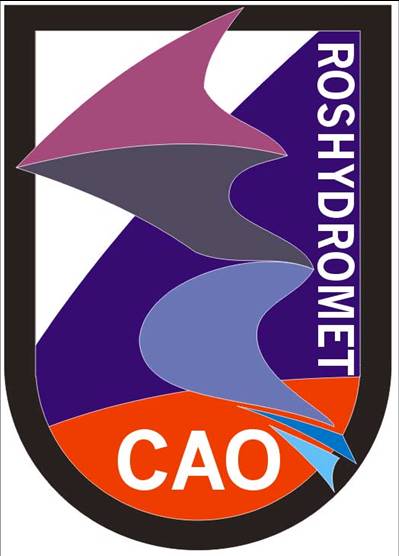
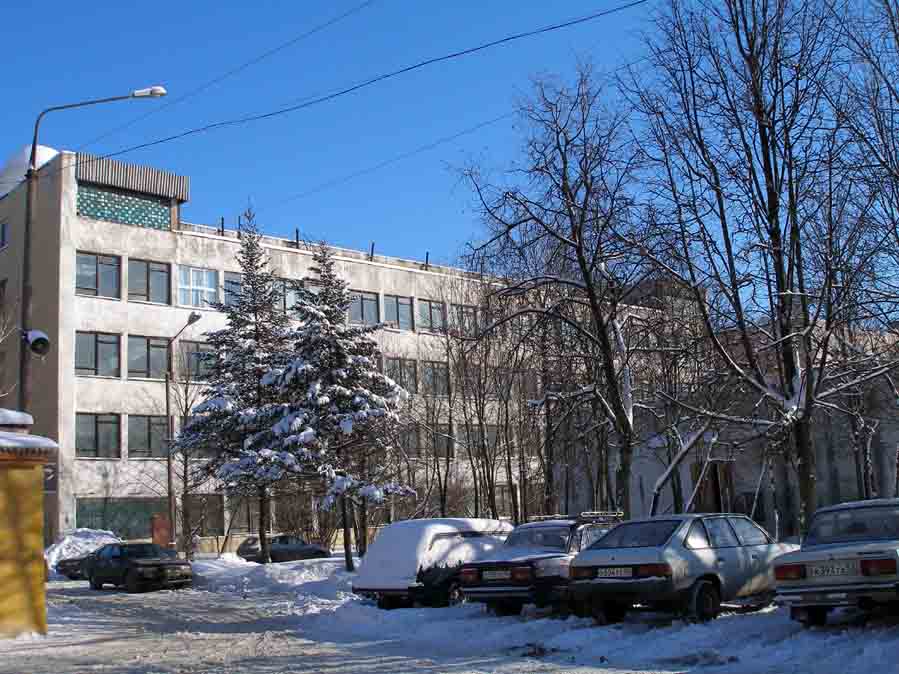
Russian version |
|
Roshydromet
CAO
DUALP
Head of Laboratory:
Dr.V.A.Yushkov
Personal and contact information
Map of visitors is available on a Russian page
|
General information
Current activities of LEMAR include following:
High-altitude aircraft M-55 “Geophysica” is equipped with the in situ instrument for ozone (FOZAN) and water vapour (FLASH) measurements. Many aircraft field campaigns under European Projects
aimed to study the chemical composition and structure of the lower atmosphere in various regions of the Earth were conducted during last years.
Optical fluorescent hygrosonde for balloon sounding (FLASH-B) (developed at CAO) provide water vapour vertical profiles from 6-8 up to 35 km. As a rule water vapour sounding is conducting jointly with ozone sounding. Simultaneous water vapour and ozone measurements are valuable data set for study of stratosphere-troposphere exchange (STE).
Modification of the regular FLASH-B hygrosonde has been developed for using on board of long duration balloon (STRATEOLE Project).
Chemilal trajectory model (developed by Dr.A.Lykyanov) is widely used for analyzing the experimental data for investigation the history of air masses arriving to the point of measurements. This model as well well-known Wei method are used for estimation the mass flow through the tropopause for Stratosphere-Troposphere-Exchange studies in extratropics.
Study of chemical ozone loss in stratospheric polar vortex in Arctic For estimation the chemical ozone loss in the stratospheric polar vortex ozone sounding with ECC is conducted during winter spring periods at Salekhard station (67N,67E) and Yakutsk station (62N, 130 E). Satellite ozone observations (SAGE-III, AURA) are also used for this purposes. On the base of radiative model the cooling rates are calculated for estimation of diabatic descent to make a corrections to observed ozone data.
|
Participation in Russian and international projects of investigation
High-altitude aircraft "Geophysica М-55" Responsible person: Dr.N.M.Sitinikov
In the period 1993-2001, within the framework of an international project, CAO jointly with Myasishchev Design Bereau and in collaboration with EC research institutes created an air-borne research laboratory on board the Russian high-altitude airplane M-55 "Geophysica" and fulfilled investigations of the chemical composition and structure of the lower atmosphere in various regions of the Earth.
In the period 1993-2006, the airplane "Geophysica" was successfully employed in 14 international flight expeditions to stidy the mechanisms of stratospheric ozone depletion in the Arctic and Antarctica and seasonal conditions of the troposphere-stratosphere exchange in tropical latitudes (the Seychelles, Brazil, Australis, Western Africa).
Also fulfilled in these flights was validation of satellite-borne measurements of space-and-time distribution of the minor atmospheric gases, including measurements from the European satellite ENVISAT and Russian "Meteor-3M".
Major M-55 "Geophysica" flight expeditions
Project name | Place & period | Subject of investigation |
1.Самолетная экспедиция
APE-POLECAT | December- January 1996-1997. Rovaniemi, Finland. 45 hours of flight time. |
Polar stratospheric clouds (PSC), ozone anomaly in Arctic, Lee waves. |
2.Самолетная экспедиция
APE-THESEO |
February-March 1999. Mahe, Сейшеловы islands. 80 hours of flight time. |
Exchange processes between upper troposphere and lower stratosphere. Tropical cyclones, «hot towers». |
3.Самолетная экспедиция
APE-GAIA | September-October 1999. Огненная Земля (Ушуайя), Аrgentina.
90
hours of flight time. | Polar stratospheric clouds (PSC), ozone hole in Antarctica, Lee waves. |
4.Самолетная экспедиция
EuPLEx, satellite ENVISAT data validation
| February-March 2003. Kirune, Sweden.
86 hours of flight time |
Polar stratospheric clouds (PSC), ozone hole in Arctic, Lee waves |
5. Самолетная экспедиция
TROCCINOX
| January-February 2004. Brasil
_ hours of flight time | Convection processes in tropics, cirus cliuds, distribution of Nitrogen Oxides
|
6. Самолетная экспедиция
SCOUT-O3 |
2005. Darvin, Australia. _ hours of flight time | Convection processes in tropics |
7. Самолетная экспедиция
AMMA
| August 2006. Burkina-Faso (Western Africa)
_ hours of flight time
|
Quantify convective transport of inorganic/organic species to upper troposphere
|
Study of chemical ozone loss in stratospheric polar vortex in Arctic
Responsible person: N.D.Tsvetkova
Our understanding of chemical and dynamical processes leading to chemical ozone loss in the winter polar stratosphere has improved significantly during last 20 years. The key role of chlorine species in the depletion of ozone occurring during cold Arctic winters and under high chlorine loading is now well demonstrated. When the temperatures are sufficiently low to allow the formation of polar stratospheric clouds (PSCs), the chlorine reservoir species HCl and ClONO2 are transformed by heterogeneous reactions into active chlorine molecules (ClOx=ClO+2Cl2O2+2Cl2) that drive catalytic ozone destruction.
For quantifying chemical ozone loss inside the Arctic polar vortex satellite (SAGE III, MLS-AURA) and sondes measurements of ozone vertical distribution are used. The regular ozonesounding in winter- spring period in Yakutsk from 1995 and in Salekhard from 1998 is carried out for this purpose.
Inside the polar vortex the ozone mixing ratio evolution on a fixed isentropic surface is caused by chemical ozone loss and diabatic descent of air masses due to diabatic cooling. So the temporal ozone change on a fixed isentropic surface is given as:

where O3 is ozone mixing ratio on Θ level, Θ – potential temperature. O3/t – the observed temporal rate of ozone change on Θ level (has been calculated from the mixing ratio time series by linear regression method), S – chemical ozone loss rate, O3/ -the ozone gradient with respect to potential temperature and /t – the diabatic cooling rate (has been calculated with the radiation scheme). Thus chemical ozone loss rate can be derived as the difference between the observed ozone change rate and the computed increase due to the diabatic descent. A decrease in total column ozone due to chemical ozone loss can be deduced by integrating of cumulative ozone loss profile at different potential temperature levels.
As illustration, figure 1 shows vertical distribution of vortex-averaged ozone loss for 3 winters – the mild winter of 2003 and extremely cold winters of 1999/2000 and 2004/2005. The record total column losses during 2004/2005 (116 ± 10 DU) demonstrates that Arctic stratospheric cooling induced by climate change could intensify polar ozone depletion against the trend of declining chlorine levels since 2000.
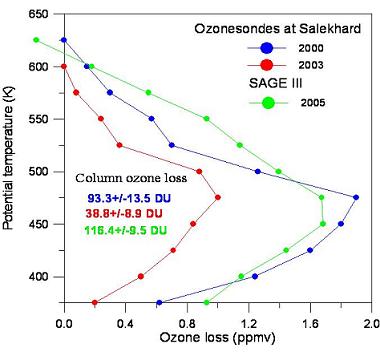
Fig. 1. Vertical distribution of vortex-averaged cumulative ozone loss during winter-spring period deduced from ozone sounding in Salekhard for winters of 2000 and 2003 and from SAGE III data for winter of 2005.
(From: Tsvetkova, N. D., Yushkov V. A., Lukjanov A. N., Dorokhov V. M., Nakane H., Record chemical ozone loss during the 2004/05 Arctic winter,
Izvestiya RAN, Atmospheric and Oceanic Physics, in Russian, in press, 2007)
|
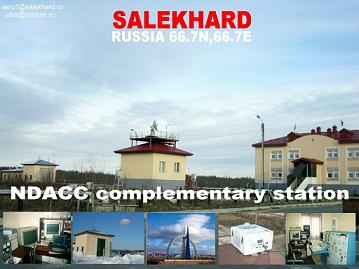
Fig.2 Complementary station for in-situ observations in Salekhard (66.70 N, 66.70 E)...
|
Optical fluorescent hygrosonde for balloon sounding (FLASH-B)
Responsible persons: Dr.S.M.Khaykin; Dr.L.I.Korshunov
The FLASH-B (FLuorescent Advanced Stratospheric Hygrometer for Balloon) instrument was developed at Central Aerological Observatory, Russia for balloon-borne water vapor measurements in the upper troposphere and stratosphere (Yushkov et al.,1998, Yushkov et al., 2000). The instrument is based on the fluorescent method (Kley and Stone, 1978; Bertaux and Dellanoy, 1978), which uses H2O molecules photodissociation at a wavelength λ < 137 nm followed by the measurement of the fluorescence of excited OH radicals. The source of Lyman-alpha radiation (λ =121.6 nm) is a hydrogen discharge lamp while the detector of OH fluorescence at 308 -316 nm is a HAMAMATSU R647-P photomultiplier run in photon counting mode with an narrowband interference filter for selecting the fluorescence spectral region. The intensity of the fluorescent light sensed by the photomultiplier is directly proportional to the water vapor mixing ratio under stratospheric conditions (30 – 150 hPa) with small oxygen absorption (3% at 50 hPa).
The precursor of FLASH-B instrument, optical hygrometer (Khaplanov et al., 1992) designed for use onboard both stratospheric balloons and rockets had a weight of about 5 kg. It participated in EASOE field campaign in 1991/92 (Khattatov et al, 1994) as well as in Arctic field balloon campaign in Russia.
The modified version of the optical hygrometer named FLASH-B (Fluorescent Advanced Stratospheric Hygrometer for Balloon) had significantly reduced dimensions and weight. It was successfully applied for water vapor measurements on board of long and short duration balloons (Yushkov et al., 2001). Based on this experience the recent version of FLASH-B integrated with Vaisala RS-80 radiosonde has been developed for regular balloon soundings.
The instrument uses the open layout [Khaplanov et al., 1992] where the optics is looking directly into the outside air. This arrangement is suitable only for nighttime measurements with a solar zenith angle larger than 980, at which sun light no longer reaches the detector. The co-axial optical layout allows reducing the size of the instrument to 106x156x242 mm with a total weight of 0.980 kg including batteries.
The accuracy of the FLASH-B instrument is determined by the calibration error estimated as 4% in the 3 – 100 ppmv range. The measurement precision is 5.5% calculated for 4 seconds integration time at stratospheric conditions. The total uncertainty of the measurement is less than 10% at the stratospheric mixing ratios greater than 3 ppmv increasing to about 20% at mixing ratios less than 3 ppmv.
In January-February 2004 FLASH-B hygrosonde took part in the international intercomparison campaign LAUTLOS-WAVVAP held at the Arctic station of Finnish Meteorological Institute. The campaign was aimed at intercomparison of different in-situ balloon as well as remote ground-based water vapour instruments. FLASH-B hygrosonde was used as a reference for stratospheric water vapour measurements. The results of comparison showed excellent agreement between different instruments and measurements techniques.
At present time FLASH-B is used for regular monthly soundings at a number of European stations, i.e. Lindenberg (Germany), Ny-Alesund (Norway), Sodankyla (Finland). In the frame of strategic framework program COPES by WCRP (2005-2015) supported by WMO it is planned to start regular water vapour soundings at Payern (Swirzerland) in cooperation with Swiss meteorological service MeteoSwiss and at Teresina (Brasil) in cooperation with the French National Centre for Scientific Research (CNRS).
Reference.
Bertaux J.L. and Delannoy A. Premieres measures stratospheriques par un hygrometre a fluorescence ultraviolette, C.R.Acad.Sc.Paris, 286, 191-194, 1978.
Kley D. and Stone E.J. Measurements of water vapor in the stratosphere by photodissotiation with Ly-alpha (1216A) light, Rev. Sci. Instrum., 49, 661-697, 1978.
Yushkov V., S. Merkulov, and Astakhov, Optical balloon hygrometer for upper stratosphere and stratosphere water vapour measurements, in Optical remote sensing of the atmosphere and clouds edited by J.Wang, B.Wu, T.Ogawa, Z-h.Guans, Proc. SPIE, 3501, 439-445, 1998.
Yushkov et al. Stratospheric water vapour measurements in the winter arctic with optical fluorescent hygrometer on short and long duration balloons, Proc. of the 15-th ESA Symposium on European rocket and Balloon Programmes, 263-268, 2001.
Khaplanov, M., V. Astakhov, A. Lukjanov, M. Kretova, and V. Yushkov, Fluorescent hygrometer for middle atmosphere measurements, Proc. 19th Annual European Meeting on Atmospheric Studies by Optical Methods, 540-545,1992.
Khattatov, V., V. Yushkov, M. Khaplanov, I. Zaitzev, J. Rosen, and N. Kjome (1994), Some results of water vapor, ozone, and aerosol balloon borne measurements during EASOE, Geophys. Res. Lett., 21(13), 1299–1302.
Yushkov, V., Sitnikov, N., Zaitcev, I., Pommereau, J.P. and Garnier, A., 2001, Stratospheric water vapor measurements in the winter arctic with optical fluorescence hygrometer on short and long duration balloons, in: Proceedings of the 15th ESA Symposium on European Rocket and Balloon programmes and Related Research, Biarritz, France, ESA SP-471, 28-31 may 2001, Warmbein, B. (ed.), ESA, 263-268.
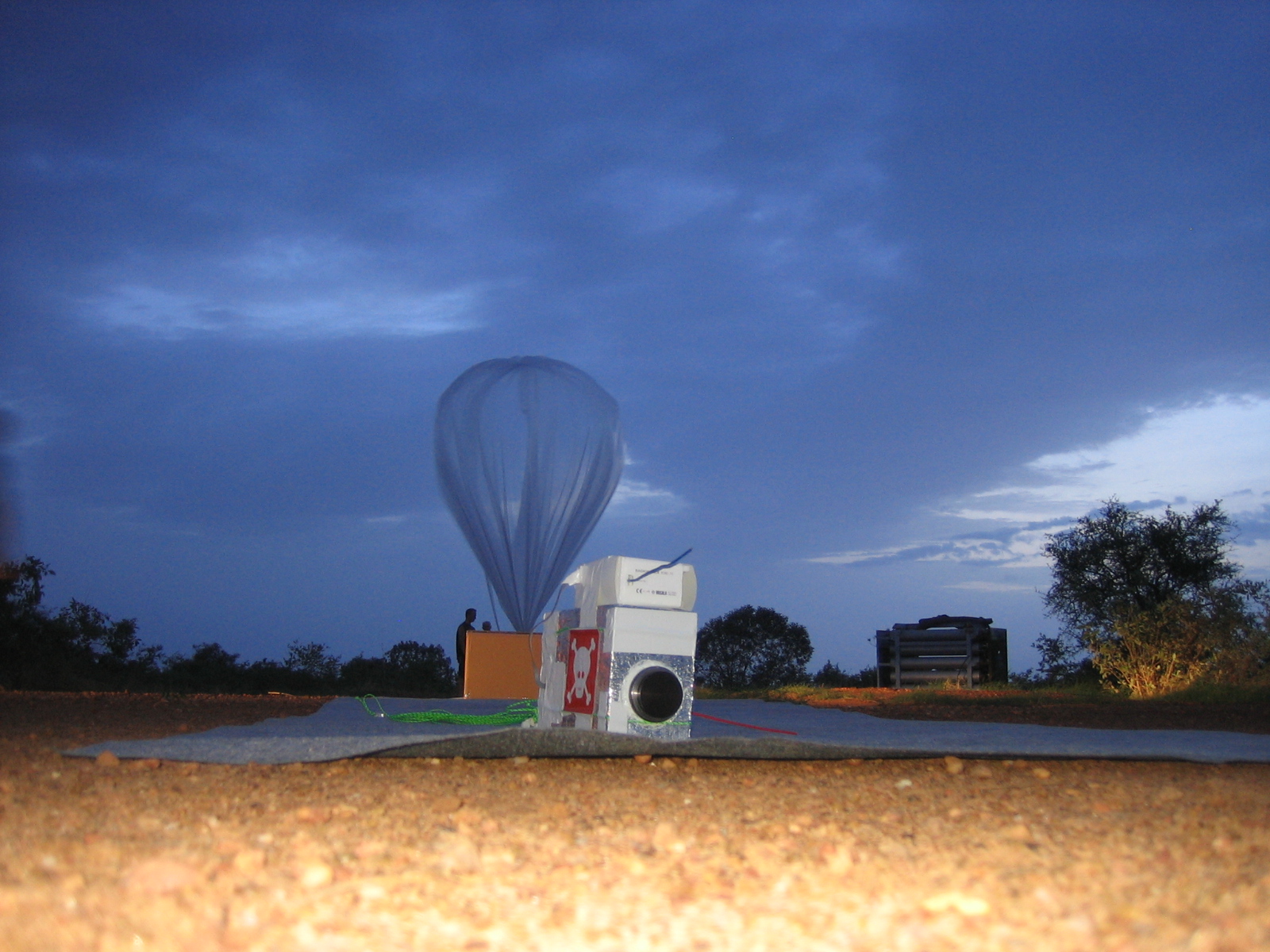 |
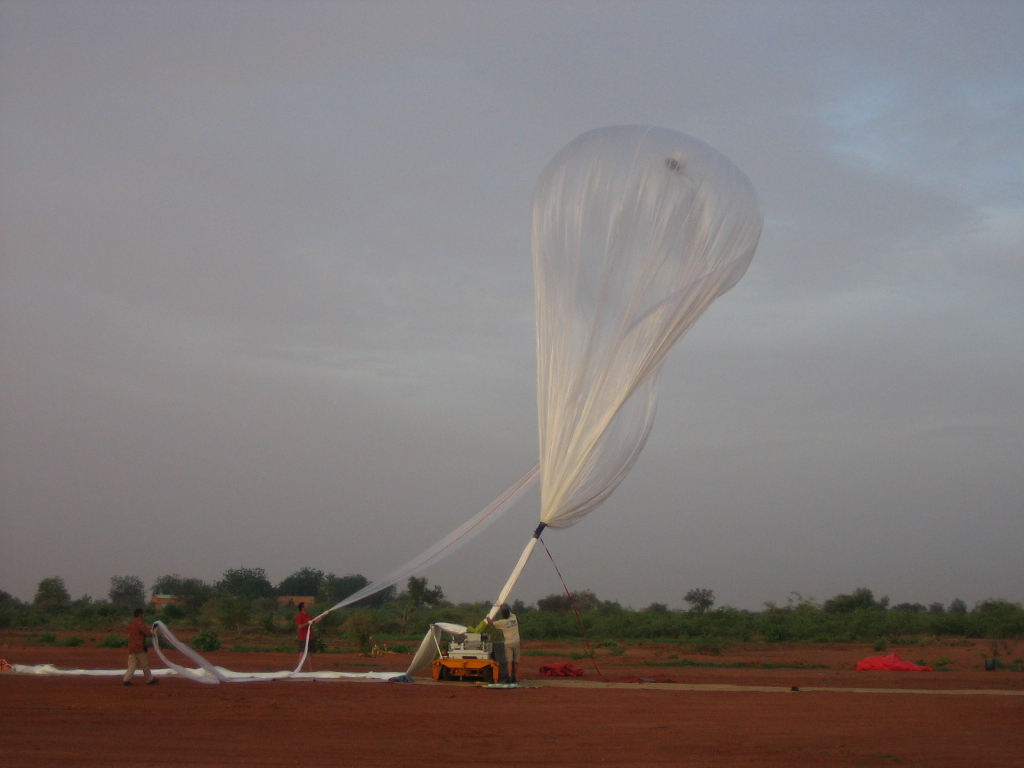 |
Hygrometer FLASH-B в связке с радиозондом Vaisala before launch in the framework of project SCOUT-AMMA (Western Africa, Niger, August 2006).
Chemilal trajectory modelling
Responsible person: Dr.A.N.Lykyanov
Model description.
A trajectory of air parcel is the Lagrangian displacement of air particle forced by wind field. The time integration of the particle advection equation expressed with spherical coordinates is performed using the fourth-order Runge-Kutta method with analyzed wind data linearly interpolated in time and space.
New horizontal coordinates of air parcel moving during time step are determined by:
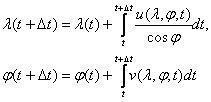 where - longitude and latitude respectively, u,v – zonal and meridional winds.
To avoid inaccuracies near the poles, for latitudes exceeding 70N and 70S, the integration was conducted using Cartesian coordinates. The time step for trajectory calculations is set to 15 minutes. Trajectory’s inaccuracies are mainly caused by the accuracy and resolution of initial analyzed data and the method of their interpolation.
where - longitude and latitude respectively, u,v – zonal and meridional winds.
To avoid inaccuracies near the poles, for latitudes exceeding 70N and 70S, the integration was conducted using Cartesian coordinates. The time step for trajectory calculations is set to 15 minutes. Trajectory’s inaccuracies are mainly caused by the accuracy and resolution of initial analyzed data and the method of their interpolation.
To calculate the isentropic trajectories the horizontal winds and the temperature are used. Potential temperature (PT) and potential vorticity (PV) are conserved when the motion is adiabatic and there are no external forces, heat sources or frictional dissipation. In the stratosphere the main diabatic source is a relatively slow radiative heating/cooling. Thus both PT and PV stay fairly constant along the stratospheric isentropic trajectory during 10-15 days. In the tropopause region and troposphere 3-d trajectories are more accurate because of diabatic sources like latent heat of evaporation or condensation and so on. To calculate 3-d trajectories the vertical analyzed wind is also used. Also, quasi-isentropic trajectories can be calculated by using cooling rates obtained from radiative schemes.
The model uses analyzed data from the European Centre for Medium-Range Weather Forecasts (ECMWF) on 21 pressure levels (troposphere/stratosphere) with horizontal resolution 2.5 х 2.5 or 0.5 х 0.5 degree and temporal resolution 6 hours.
The initial objective of the trajectory model development was an investigation of the chemical ozone depletion inside the polar stratospheric vortex including the Antarctic “ozone hole”. The trajectory model has been coupled with chemistry model included the gaseous and heterogeneous reactions. The example of model simulations in both hemispheres is presented in Fig.1 . The more detailed model description and applications are described in Lukyanov et al., 2003.
Also the model is widely used for analysis of balloon and aircraft data. The backward trajectories indicate on the origin of air masses arriving to observational locations. An example of the trajectory analysis of laminated water vapour profile obtained in the vortex-edge region is shown in
Fig.2. Results of RDF calculations with potential vorticity (PV) as advected tracer show that such a structure was caused by the differential advection. The vortex filaments with enhanced PV and water vapour occurred in the region of measurements. In more details it is shown in (3).
At present the trajectory model also is coupled with cirrus parameterization model
(Ren, MakKenzie, Cirrus parameterization and the role of ice nuclei, QJRMS, 131, 2005), developed at University of Lancaster (UK). The coupled model provides more realistic estimates of dehydration of the humid tropospheric air entering into the stratosphere.
Also the trajectories can be applied for trajectory mapping of satellite data
(Лукьянов А.Н., «Эволюция озона и озоноактивных компонент в нижней стратосфере полярных широт в зимне-весенний период», Диссертация на соискание степени кандидата физ-мат. наук, 2001.) and pollution studies.
Investigation of dynamical processes in the stratosphere-troposphere of Arctic and Antarctic
Responsible person: Dr.P.N.Vargin
Main research objectives:
Dynamical processes in troposphere - stratosphere
Sudden Stratospheric Warmings
Ozone layer changes
Interannual variability of stratospheric circulation in Arctic and Antarctic during winter seasons strongly depends on Sudden Stratospheric Warmings (SSW).
During SSW event temperature of polar stratosphere increases and zonal circulation weakens strongly and could change its direction from westerlies to easterlies.
As a result of SSW stratospheric polar vortex could be shifted from the Pole and its shape could be changed. Most intensive SSW event - Major could lead to stratospheric polar vortex breaking. If in Northern hemisphere Major SSW are observed rather regularly, there was only one Major SSW in the Antarctic in September 2002.
Although SSW develops often differently its basic features are known. Therefore the diagnostic and investigation of each SSW event is still of great interest, especially investigation of dynamical processes that are responsible for SSW occurrence.
SSW events influence strongly dynamical and chemical processes in polar stratosphere and troposphere, particularly ozone destruction by heteroheneous reaction on particles of Polar Stratospheric Clouds (PSC).
Publication on SSW
Peters D., P.Vargin, A.Gabriel, N.Tsvetkova and V.Yushkov, Tropospheric forcing of the boreal polar vortex splitting in January 2003; Annales Geophysicae, 28, p.1–16, 2010.
Peters, D., P. Vargin and H. Körnich, A Study of the Zonally Asymmetric Tropospheric Forcing of the Austral Vortex Splitting During September 2002. Tellus , 2007, 59A, p.384–394;
Publications in reviewed journals
(in reverse chronological order)
Updated list of publications 2011-2012
2010 2009
2008 2007
2006 2005
2004 2003
2002 2001
2000 1999
1998 1997
1996 1995
1994 1993
1992
-----2010--------
Vargin P.N., V.A.Yushkov, S.M.Haikin, N.D.Tsvetkova, S.V.Kostrykin, E.M.Volodin; Climatic Changes and Middle Atmosphere - Undecided Questions;
Vestnik of Russian Academy of Science, vol.80, N 2, p.114-124, 2010
-----2009--------
Khaykin, S., Pommereau, J.-P., Korshunov, L., Yushkov, V., Nielsen,
J., Larsen, N., Christensen, T., Garnier, A., Lukyanov, A., and Williams,
E.: Hydration of the lower stratosphere by ice crystal geysers over land
convective systems, Atmos. Chem. Phys., 9, 2275-2287, 2009.
S.M.Haikin, V.A.Yushkov, L.I.Korshunov, A.N.Lukyanov, J.-P. Pomerau, Й.
Nilsen, Х.Fomel "Влажность тропической нижней стратосферы: наблюдения и
анализ" // Izvestia of RAS. Physics of atmosphere and ocean, ...., 2009.
-----2008--------
1. Khaykin,S., J.-P. Pommereau, L. Korshunov, V. Yushkov, J. Nielsen, N. Larsen, T. Christensen, A. Garnier, A. Lukyanov, and E. Williams (2008) Hydration of the lower stratosphere by ice crystal geysers over land convective systems // Atmos. Chem. Phys. Discuss., 8, 15463-15490, 2008
2. Lukyanov A.N., А.Н., Карпечко А.Ю., V.A.Yushkov, Коршунов Л.И., S.M.Haikin, Кюрё Э., Киви Р., Матурилли М., Фомель Х., «Перенос водяного пара и озона в верхней
тропосфере-нижней стратосфере и стратосферно-тропосферный обмен во время
проведения кампании LAUTLOS », в печати Изв. АН, Физика Атмосферы и Океана.
3. Kiemle C., M.Wirth, A. Fix, G. Ehret, U.Schumann, T. Gardiner, C.Schiller, N. Sitnikov and G. Stiller; First airborne water vapor lidar measurements in the tropical upper troposphere and mid-latitudes lower stratosphere: accuracy evaluation and intercomparisons with other instruments.
Atmos. Chem. Phys. Discuss., 8, 10353-10396, 2008
www.atmos-chem-phys-discuss.net/8/10353/2008/
4. Müller S., N. Kämpfer, D. G. Feist, A. Haefele, M. Milz , N. Sitnikov, C. Schiller, C. Kiemle, and
J. Urban; Validation of stratospheric water vapour measurements from the airborne
microwave radiometer AMSOS. Atmos. Chem. Phys. Discuss., 8, 1635-1671, 2008
www.atmos-chem-phys-discuss.net/8/1635/2008/
5. C. Kiemle, M. Wirth, A. Fix, G. Ehret, U. Schumann1, T. Gardiner, C. Schiller3, N.
Sitnikov4, and G. Stiller. First airborne water vapor lidar measurements in the tropical upper troposphere and mid-latitudes lower stratosphere: accuracy evaluation and intercomparisons with other instruments. Atmos. Chem. Phys. Discuss., 8, 10353–10396, 2008
www.atmos-chem-phys-discuss.net/8/10353/2008/
6. E. V. Ivanova, C. M. Volk, O. Riediger, H. Klein, N. M. Sitnikov, A. E. Ulanovskii, V.A.
Yushkov, F. Ravegnani, T. M¨obius1, and U. Schmidt. A quasi-Lagrangian
coordinate system based on high resolution tracer observations: Implementation
for the Antarctic polar vortex. Atmos. Chem. Phys. Discuss., 8, 16123–16173,
2008, www.atmos-chem-phys-discuss.net/8/16123/2008/
7. Keim C., G.Y. Liu, C.E. Blom, H. Fischer, T. Gulde, M. Hopfner, C. Piesch, F. Ravegnani,
A. Roiger, H. Schlager and N. Sitnikov. Vertical profile of peroxyacetyl nitrate (PAN) from MIPAS-STR measurements over Brazil in February 2005 and the role of PAN in the UT tropical
NOy partitioning. Atmos. Chem. Phys. Discuss., 8, 6983–7016, 2008,
www.atmos-chem-phys-discuss.net/8/6983/2008/
8. Corti T., Luo B.P., de Reus M., Brunner D., Cairo F., Mahoney M.J., Martucci G., Matthey R., Mitev V., dos Santos F.H., Schiller C., Shur G., Sitnikov N.M., Spelten N, Vössing H.J.,
Borrmann S., Peter T., 2008: Unprecedented evidence for deep convection
hydrating the tropical stratosphere. Geophys. Res. Lett., 35, L10810.
9. Voigt, C., H. Schlager, A. Roiger,
A. Stenke, M. de Reus, S. Borrmann, E.Jensen, C. Schiller, P. Konopka and N.
Sitnikov, Detection of reactive
nitrogen containing particles in the tropopause region - evidence for a tropical nitric acid trihydrate (NAT) belt, Atmos. Chem. Phys.Discuss., 8, 14145-14168, 2008.
10. Corti, T., B. P.Luo, M.de Reus, D. Brunner, F. Cairo, M. J. Mahoney, G. Martucci, R. Matthey, V. Mitev, F.H. dos Santos, C. Schiller, G. Shur, N. M. Sitnikov,
N. Spelten, H. J. Vössing, S. Borrmann and T.Peter, Unprecedented evidence for overshooting convection hydrating the tropical stratosphere, Geophys. Res. Lett., 35, doi:10.1029/2008 >GL033641,2008.
-----2007--------
2. Karpechko, A., A. Lukyanov, E. Kyro, S. Khaikin, L. Korshunov, R.Kivi and H. Vomel (2007), The water vapour distribution in the Arctic lowermost stratosphere during the LAUTLOS
campaign and related transport processes including stratosphere-troposphere exchange, Atmos. Chem. Phys., V. 7, pp. 107-119.
3. Voemel H., V.Yushkov, S.Khaykin, L.Korshunov , E.Kyro, R.Kivi; Intercomparision of Stratospheric Water Vapour Sensors: FLASH-B and NOAA/CDML Frost-Point Hydrometer, J. of Atmos. and Ocean Technology, vol.24, June, p.941-952, 2007.
4. Peters, D., P. Vargin and H. Körnich, A Study of the Zonally Asymmetric Tropospheric Forcing of the Austral Vortex Splitting During September 2002. Tellus, 59A, p.384–394, 2007;
Abstract
-----2006--------
5. Maturilli M., F.Fierli, V.Yushkov, A.Lukyanov, S.Khaykin, A.Hauchecorne; Stratospheric water vapour in the vicinity of the Arctic polar vortex; Ann. Geophys., 24, p.1511-1521, 2006 Abstract
6. Karpechko, A., A.Lukyanov, E.Kyrö, S.Khaykin, L. Korshunov, R. Kivi, H.Vömel "The water vapour distribution in the Arctic lowermost stratosphere during LAUTLOS campaign and related transport processes including stratosphere-troposphere exchange" Atmospheric Chemistry and Physics Discussions, 6, p.4727-4754, 2006 Abstract
7. MacKenzie F.R., C.Schiller, T.Peter, J.Beuermann, O.Bujok, F.Cairo, T.Corti, V.Yushkov; Tropopause and hygropause variability over the equator Indian Ocean during February and March 1999, J.Geophys.Res., vol.111, D18112, 2006
Abstract
-----2005--------
8. Yushkov V.A., A.N.Lukyanov, S.M.Khaikin, L.I.Korshunov, R.Neuber, M.Muller, E.Kuro, R.Kivi, H.Voemel, Y.Sasano, H.Nakane; Vertical Distribution of Water Vapor in the Arctic Stratosphere in January February 2004 from Data
of the LAUTLOS Field Campaign, Izvestiya RAS, Atmospheric and Oceanic Physics; vol.41, № 5, p.563-570, 2005. Abstract.
9. Deuber, B., A.Haefele, D.G.Feist, L.Martin, N.Kampfer, G.E.Nedoluha, V.Yushkov, S.Khaykin, R.Kivi, and H.Vomel, Middle Atmospheric Water Vapour Radiometer (MIAWARA): Validation and first results of the LAPBIAT Upper Tropospheric Lower Stratospheric Water Vapour Validation Project (LAUTLOS-WAVVAP) campaign, Journal of the Geophysical Research, 110, D13306, doi:10.1029/2004JD005543, 2005.
Abstract
10. Vandaele, A.C., C.Fayt, F.Hendrick, C.Hermans, F.Humbled, M.Van Roozendael, M.Gil, M.Navarro, O.Puentedura, M.Yela, G.Braathen, K. Stebel, K.Tørnkvist, P.Johnston, K.Kreher, F.Goutail, A.Mieville, J.-P. Pommereau, S.Khaikine, A.Richter, H.Oetjen, F.Wittrock, S. Bugarski, U.Frieß, K.Pfeilsticker, R.Sinreich, T.Wagner, G.Corlett, and R.Leigh, An intercomparison campaign of ground-based UV-visible measurements of NO2, BrO, and OClO slant columns: Methods of analysis and results for NO2, Journal of the Geophysical Research, 110,D08305, doi:10.1029/2004JD005423, 2005.
Abstract.
-----2004--------
11. Ulanovskii A.E., A.N.Lukyanov, V.A.Yushkov, N.M.Sitnikov, M.Volk,
E.V.Ivanova, and F.Ravegnani, Estimation of the Chemical Loss of Ozone in
the Antarctic Stratosphere in the 1999 Winter-Spring Season from Direct Measurements and Simulations, Izvestiya RAS, Atmospheric and Oceanic Physics, vol.40, No.6, p.695-703, 2004, Abstract.
-----2003--------
12. Lukyanov A., Nakane H., Yushkov V., Lagrangian Estimation of Ozone Loss in the core and Edge Region of the Arctic Polar Vortex 1995/1996: Model Results and Observations. Journal of Atmospheric Chemistry. vol.44, p.191-210, 2003. Abstract
13. Khaikin, S., D.V.Ignatiev, V.Dorokhov, J.-P.Pommereau, O.Mieville, F.Goutail, J.-C.Lambert,
Investigation of the influence of geophysical factors on satellite-based GOME total O3 and NO2 measurements: Comparison with ground-based observations with SAOZ in polar latitudes,
Issledovaniya Zemli iz Kosmosa, No. 3, pp. 1-11, (in Russian), 2003.
Abstract
-----2002--------
14. Tsvetkova N.D., H.Nakane, A.N.Lukyanov, V.A.Yushkov, V.M.Dorokhov, I.G.Zaitsev, V.I.Sitnikova; Estimation of the Winter–Spring Rates of Ozone Depletion within the Stratospheric Arctic Cyclone in Siberia in 1995–2000 from Balloon Measurements; Izvestiya RAS, Atmospheric and Oceanic Physics; vol 38, №2, p.184-192, 2002, Abstract.
15. Юшков В.А., Х. Накане, Н.Д. Цветкова, В.М. Дорохов, В.И. Ситникова, А.Н. Лукьянов «Исследование состояния озонового слоя в зимне-весенний период 2000 г. с помощью баллонных измерений и наземных наблюдений в Сибири» - Метеорология и гидролология, , №12, с. 27-34, 2002.
-----2001--------
16. Ulanovsky, A.E., V.A.Yushkov, N.M.Sitnikov, F.Raqvengnani; The FOZAN-II fast-response chemiluminescent airborne ozone analyser. Instruments and Experimental Techniques 44: p.249-256, 2001.
-----2000--------
17. Lukyanov A.N., V.A.Yushkov, H.Nakane, H.Akiioshi; Trajectory Photochemical Model for the Lower Stratosphere, Izvestiya RAS, Atmospheric and Oceanic Physics; vol.36, № 6, p.755-762, 2000 ...
-----1999--------
18. Юшков В.А., Дорохов В.М., Цветкова Н.Д., Лукъянов А.Н.,Зайцев И.Г., Меркулов С.Н, «Анализ высоты тропо-, озоно- и гигропаузы над Якутском в зимне-весенний периоды 1995-1997 гг.», Метеорология и гидрология, N2 стр 81-86, 1999.
-----1998--------
19. Knudsen, B., Larsen, N., Mikkelsen, I. S., Morcrette, J.-J., Braathen, G. O., Kyrö, E., Fast, H., Gernandt, H., Kanzawa, H., Nakane, H., Dorokhov, V., Yushkov, V., Hansen, G., Gil, M., and Shearman, R. J.,
Ozone depletion in and below the Arctic vortex for 1997, Geophys. Res. Lett., 25(5), 627-630, 10.1029/98GL00300, 1998. [Abstract]
-----1997--------
20. Rex.M., N.Harris, P.Gathen, R.Lehmann, G.Braathen, E.Reimer, A.Beck, M. Chipperfield, R.Alfier, M.Allaart, F.O’Connor, H.Dier, V.Dorokhov, H.Fast, M.Gil, E.Kyrö, Z.Litynska, S.Mikkelsen, M. Molyneux, H.Nakane, J.Notholt, M.Rummukainen, P.Viatte and J.Wenger, Prolonged stratospheric ozone loss in the 1995/96 Arctic winter, Nature, 389, 835-838, 1997
-----1996--------
21. Dorokhov, V.M., T.E.Potapova, F.Goutail, J.-P.Pommereau, Study of negative anomaly of total ozone in the region of East Siberia ozone maximum during winter-spring period of 1995, Meteorologiia i Gidrologiia, No. 6, pp. 82-91, (in Russian), 1996.
-----1995--------
22. Dorokhov V.M., and T. E. Potapova, Observations of total ozone at hight Arctic latitudes, Optika atmosphery i okeana, vol. 8, No. 06, pp. 868-874, (in Russian), 1995.
-----1994--------
23. Юшков В.А., В.У. Хаттатов, И.Г. Зайцев, М.Г. Хапланов, А.Н. Лукьянов, Дж. Розен, Н. Кьёме, «Некоторые результаты прямых одновременных измерений озона, аэрозоля и водяного пара в стратосфере с борта аэростата», Метеорология и гидролология, , №12, с. 98-103, 1994.
-----1993--------
-----1992--------
24. Лукьянов А.Н., М.Г. Хапланов, Н.Л. Шолохова, В.А. Юшков, «Учёт влияния скорости потока на результаты измерения влажности оптическим гигрометром на метеоракете», Тр. ЦАО, 179, 69-73, 1992
25. Лукьянов А.Н., А.В. Панасенко, В.А. Юшков, «Применение численного метода конечных объёмов для исследования течения вязкого теплопроводного газа вблизи контактного датчика», Тр. ЦАО, 179, 62-68, 1992
Thesises of presentations
1. Шифрин Д.М., Ситников Н.М., Мобильный комплекс на основе привязного аэростата для мониторинга атмосферы. Тезисы докладов всероссийской научной конференции «Исследование
процессов в нижней атмосфере при помощи высотных сооружений» 8-10 октября 2008
года, Обнинск, с 89-92.
2. Ситников Н.М., Шлягер Г., Ситникова В.И., Равеньяни Ф., Улановский А.Э., Ройгер А.,
Лихзтенштерн М., Сток П. Исследование распределения двуокиси азота
хемилюминесцентным методом в зоне интенсивного судоходства (по результатам
полевой кампании проекта Quantify» (в июне 2007 года). Тезисы докладов всероссийской научной конференции «Исследование процессов в нижней атмосфере при помощи высотных сооружений» 8-10 октября 2008 года, Обнинск, с 113-117.
3. Максютов Ш., Кояма Ю., Беликов Д., Мачида Т., Шимояма К., Лукьянов, А. Ганьшин А., Кирюшов Б., Журавлёв Р., Аршинов М., Краснов О., Моделирование атмосферного СО2 в Западной Сибири и сравнение с наблюдениями, доклад на Всероссийской научной конференции «Исследование
процессов в нижней атмосфере при помощи высотных сооружений, Обнинск, 2008
4. Lukyanov А, S. Maksyutov, V.Yushkov, S.Khaykin, B.Kiryushov, R.Zhuravlev,A. Ganshin, Cirrus model simulations and transport model development, report at GOSAT meeting, Tokyo, 2008
5. Tsvetkova N., Dorokhov V., Yushkov V., Nakane H., Lukjanov A. Ozone loss in the Arctic polar vortex: Salekhard balloon sounding in the winter 2006/07; Quadrennial Ozone Symposium, Tromsø, Norway, June 29-July 5, 2008
6.Vargin P., Tsvetkova N., Yushkov V., Lykyanov A., Lapshova E.; A case study of planetary wave activity influence on the stratospheric polar vortex during Arctic winter 2002-03 and 2004-2005; Abstract of Quadrennial Ozone Symposium, (Tromse, Norway,) 2008
5. Khaykin S., Pommereau, Vomel, Korshunov L., Yushkov V.A., J.Nielsen; Water vapour in the tropical UTLS from balloon observations with FLASH B hygrometer.Geophysical Research Abstracts, Vol.10, EGU 2008 A-00444, 2008. EGU General Assembly 13.04-21.04.2008
4. Khaykin, S., Yushkov,V., Korshunov,L., Sitnikov,N., Lukyanov,A., Maturilli M., Leiterer U., Voemel H., Kyrö, E., Karpetchko,A; FLASH-B Lyman-alpha hygrosonde for UT/LS: instrument design, observations and comparison, EGU General Assembly 2006, 2-7 April, Vienna, Austria, European Geosciences Union, 2006, Geophysical Research Abstracts, V.8 , P.00536, 2006.
5. Khaykin, S., Yushkov, V., Lukyanov, A., Korshunov, L., Maturilli, M., Kyrö, E., Karpetchko, A.; Characterization of stratospheric water vapour vertical distribution in the Arctic from balloon observations during the recent winters, EGU General Assembly 2006, 2-7 April, Vienna, Austria, European Geosciences Union, 2006, Geophysical Research Abstracts, V.8 , P. 04437, 2006.
4. Karpechko,A., Lukyanov,A.; Kyro,E.; Khaikin,S.; Korshunov,L.; Kivi,R.; Voemel,H.
The water vapour distribution in the Arctic lowermost stratosphere during LAUTLOS campaign and related transport processes including stratosphere-troposphere exchange, EGU General Assembly 2006, 2-7 April, Vienna, Austria, European Geosciences Union, 2006, Geophysical Research Abstracts, V.8 , P. 07653.
5. Lukyanov, A.; Karpechko, A.; Yushkov,V.; Kyro, E. Trajectory studies of stratosphere-troposphere exchange in extratropics: a case study, EGU General Assembly 2006, 2-7 April, Vienna, Austria, European Geosciences Union, 2006, Geophysical Research Abstracts, V.8 , P. 04407, 2006.
6. Tsvetkova,N.; Yushkov,V.; Trepte,C.; von der Gathen, P. Ozone depletion in the Artic winter 2004/05 derived from the satellite (SAGE-III) and balloon measurements, EGU General Assembly 2006, 2-7 April, Vienna, Austria, European Geosciences Union, 2006, Geophysical Research Abstracts, V.8 , P. 06863.
7. Yushkov, V.; Sitnikov, N.; Ulanovsky,A.; Ravegnani, F., Some results of in situ water vapour and ozone measurements in the tropical UTLS on board of high-altitude aircraft M-55 “Geophysica”, EGU General Assembly 2006, 2-7 April, Vienna, Austria, European Geosciences Union, 2006, Geophysical Research Abstracts, V.8 , p.06650.
8. S. Khaykin, V.Yushkov, L.Korshunov, A.Lukyanov, N. Sitnikov. FLASH-B Lyman-alpha hygrosonde for UT/LS: instrument design, observations and comparison, Report from the NDACC meeting on atmospheric water vapour measurement, Bern, Switzerland, 5-7 July 2006., ed. by G. Braathens, p.4-5, 2006.
9. Ulanovsky A., V.Yushkov, F.Ravegnani, N.Sitnikov, A.Lukyanov. In situ studies of Antarctic ozone hole in September 1999 from on board the high altitude aircraft M-55 geophysica during the APE-GAIA campaign. Sixth European Symposium on stratospheric ozone, Goteborg, Sweden, Abstracts of Presentation, p. 231, 2002.
10. Tsvetkova N., H.Nakane,V.Yushkov, A.Lukyanov, V.Dorokhov, I.Zaitzev. Ozone depletion inside the Arctic polar vortex inferred from balloon measurements in Siberia since 1995. Proceedings of the sixth European symposium, Göteborg, Sweden, pp.462-465, 2002.
11. Lukyanov A., V.Yushkov, H.Nakane, H. Akiyoshi, Ozone loss rate from box model studies and ozonesonde data along the air mass trajectories arriving at Yakutsk station in winter-spring season. Proceedings of the 4-th European Symposium on Ozone Research, p. 297-300, 1997



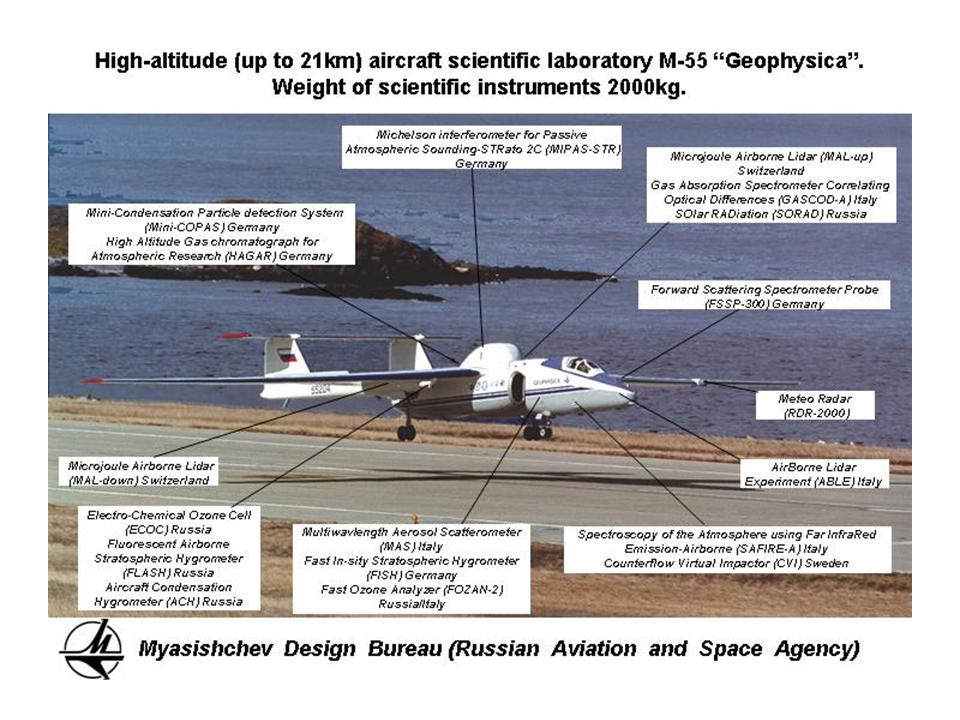
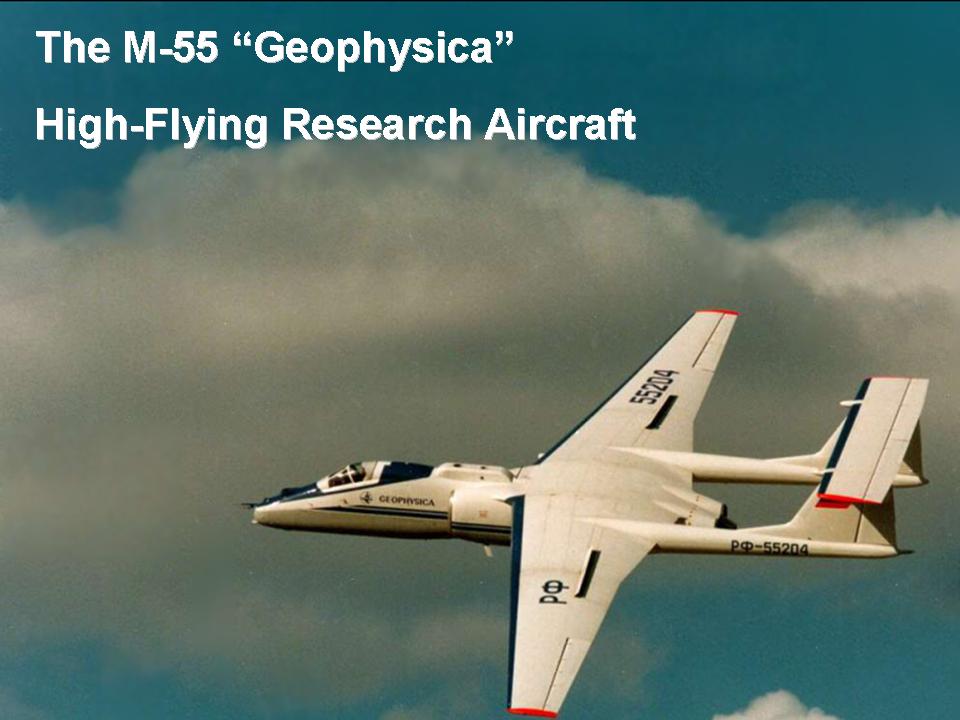
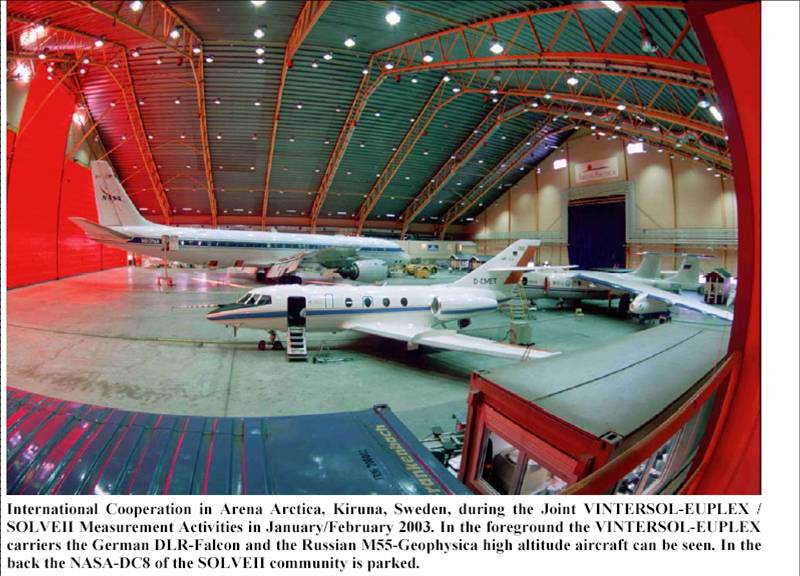
 where - longitude and latitude respectively, u,v – zonal and meridional winds.
To avoid inaccuracies near the poles, for latitudes exceeding 70N and 70S, the integration was conducted using Cartesian coordinates. The time step for trajectory calculations is set to 15 minutes. Trajectory’s inaccuracies are mainly caused by the accuracy and resolution of initial analyzed data and the method of their interpolation.
where - longitude and latitude respectively, u,v – zonal and meridional winds.
To avoid inaccuracies near the poles, for latitudes exceeding 70N and 70S, the integration was conducted using Cartesian coordinates. The time step for trajectory calculations is set to 15 minutes. Trajectory’s inaccuracies are mainly caused by the accuracy and resolution of initial analyzed data and the method of their interpolation.